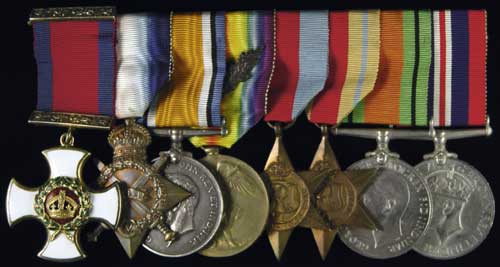
Auction: 7012 - Orders, Decorations, Medals & Militaria
Lot: 548
The Superb and Most Unusual Great War D.S.O. Group of Eight to Wing Commander R.B. Lovemore Royal Air Force, Late Royal Flying Corps and London Regiment, Who Was Credited with Two 1918 Victories and for Saving the Life of a Fellow Pilot after They had Both Been Shot Down Behind Enemy Lines a) Distinguished Service Order, G.V.R., silver-gilt and enamel, with integral top riband bar b) 1914-15 Star (Pte. R.B. Lovemore 5th M.R.) c) British War and Victory Medals, M.I.D. Oakleaves (Lieut. R.B. Lovemore. R.A.F.) d) 1939-1945 Star e) Africa Star f) Defence and War Medals, very fine or better, with M.I.D. Certificate, Lieutenant General J.L. van Deventer, K.C.B., dated 11.10.1917 (Royal Flying Corps, 2nd Lt. R.B. Lovemore, R. Fus.), and three portrait photographs of the recipient and a number of others from different periods of his life (lot) Estimate £ 3,800-4,200 D.S.O. London Gazette 8.2.1919 Lieutenant Robert Baillie Lovemore, R.A.F. (France). ´On 28 Oct. this officer, attacked by two Fokkers, was driven down and compelled to land on marshy ground the enemy side of a river. Having extricated himself from his machine, he saw another of our machines land a short distance away, the pilot being thrown out; proceeding to the spot, Lieut. Lovemore found the pilot insensible, his head and shoulders under water, and the fuselage over his legs. Releasing him from the fuselage, he dragged him out of the water, and in a few minutes the pilot recovered his senses. Lieut. Lovemore then proceeded towards the river, and seeing a corporal of ours on the other side he directed him to go and get help, he himself returning to the pilot, whom he carried to the river bank. On arriving there he saw an Infantry Officer on the opposite bank, who swam across to join him, and between them they carried the pilot down to the river and swam across, holding him up. The enemy by this time had brought up machine guns, so that they were under fire when swimming across; they, however, got across in safety, and a stretcher party arriving, the pilot was carried back to our lines. The cool courage and disregard of danger displayed by Lieut. Lovemore is deserving of very high praise.´ Wing Commander Robert Baillie Lovemore, D.S.O. (1893-1978), born ´Mbabane, Swaziland, the son of W.B. Lovemore JP of Swaziland, he is believed to be only the second white child born in that country; educated at Michaelhouse, Natal; joined 4 Troop E Squadron, Imperial Light Horse (5th Mounted Rifles), 1914; served during the Great War with the regiment in the German S.W. African Campaign, 1914-15 (severely wounded, M.I.D.); embarked for England and joined the Inns of Court O.T.C., July 1915; commissioned Second Lieutenant 3rd Battalion London Regiment, July 1916; volunteered for service with the Royal Flying Corps and was posted for training, learning to fly at Salisbury Plain on the Maurice Farman Shorthorn; gaining his wings after only 35 hours in Avro 504Ks; posted to 26 Squadron, German East Africa (BE2Cs), December 1916; contracted Malaria and was invalided to hospital in Cairo, September 1917; returned to England before being posted to 29 Squadron, France (SE5 fighters), September 1918; Lovemore has two recorded victories with squadron (6.10.1918 and 4.11.1918), the latter being a hostile balloon, which he brought down a week after himself being shot down and managing to evade capture (see D.S.O. citation); in a later interview Lovemore is given as having ´shot down three Fokkers and a captive balloon´; true to his place of birth he flew in a special SE5 donated by the Chief Regent and the chiefs of Swaziland; after receiving his D.S.O. from the King at Buckingham Palace in 1919, Lovemore returned to South Africa and took up farming in Port Elizabeth; he became a civilian pilot in the early 1930´s, having been persuaded to join a small air service company (Union Airways) by his old comrade from the R.F.C., Major A. Miller; Union Airways was the only air service in existence in South Africa at the time, and was taken over by the State in February 1934, becoming South African Airways; following the State takeover Lovemore was approached by Sir J.P. de Villiers (Head of the South African Police) with a view to forming an air wing of the service, and in light of this he became the only person in the force to have the rank of Captain; the plans never came to fruition and after a few years of service he once again became a civilian pilot and instructor this time for Wilson Airways, Kenya; with the outbreak of the Second World War Lovemore was placed in charge of forming the Kenyan African Air Unit - this was to act as a feeder unit for pilots to go on to serve with the R.A.F.; with the eventual secondment of the unit to the R.A.F., Lovemore was posted as second-in-command of a Transport Squadron based at Khartoum; further postings during the War included several months with 117 Squadron; Officer Commanding No. 7 Elementary Flying Training School, Kroonstad, South Africa; and a similar posting at No. 6 E.F.T.S., Potchefstroom; after the War Lovemore´s vast experience was continued to be recognised by the R.A.F and he was offered a promotion to Group Captain and the position of Officer Commanding an R.A.F. installation in Singapore, however he chose to return to farming in Port Elizabeth.
Sold for
£5,000




